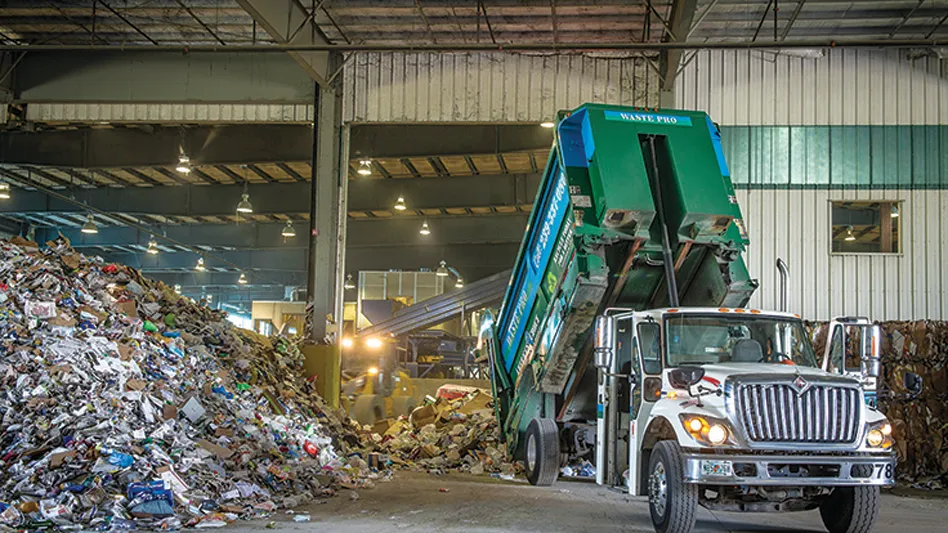
Fire Rover, a West Bloomfield, Michigan-based fire safety and suppression company, has reported that more facility fires occurred in 2022 than in previous years. The company reports approximately 390 fire incidents occurred at material recovery facilities (MRFs) in 2022 compared with 367 in 2021.
During a March 14 presentation hosted by the Arlington, Virginia-based National Waste & Recycling Association, Ryan Fogelman, vice president of strategic partnerships at Fire Rover, discussed data compiled in the company’s sixth annual “Reported Waste & Recycling Facility Fires US/CAN.” He also discussed what businesses can do to mitigate the risk of fires.
“In 2022, we had more fires than we’ve ever had [since we began putting this report together],” Fogelman said. “The data we’re tracking is based on reported incidents ... That’s a very, very conservative number.”
RELATED: Tamping down the flames
Fogelman added that based on some extrapolation, he estimates more than 2,000 fire incidents occurred at MRFs last year. This data is based on the assumptions from the data the U.K. Environment Agency has collected over the years.
“I take the reported numbers and use a six-times assumption based on the reported numbers from the U.K.,” Fogleman says in a statement to Recycling Today. “In the U.K., they require reporting from their waste and recycling operators. In the U.S., we do not. I use the reported numbers. When we assume that the ‘reported’ fires are the larger fires, we can use simple population extrapolation to get a six-times comfortable number. There are 60 million people in the U.K. and 360 million U.S. and Canadians.”
Based on the number of MRFs, scrap yards and transfer stations in North America, estimated by the Raleigh, North Carolina-based Environmental Research & Education Foundation, more than 30 percent of facilities in the U.S. and Canada suffered from a two-plus alarm fire in 2022.
According to Fire Rover’s data, the months of February, May, June and October had the most facility fires in 2022, and these months had more reported fires than the same months in previous years.
Fogelman said waste, paper and plastic facilities saw a 19 percent increase in fire incidents while organics facilities saw a 23 percent increase. Additionally, scrap metal facilities saw a 3 percent increase in fire incidents.
He added that 50 percent of the fires at facilities are due to lithium-ion batteries, and about 50 percent are traditional hazards that cause fires, including propane tanks, accelerants, chemicals, flares, hot charcoal, cigarette butts and more.
“I have hope that over the next couple of years, we’re going to start to see those numbers go down,” Fogelman said during the webinar. “Unfortunately, what’s happening is there are so many batteries that are getting into the waste and recycling stream [because of increased usage].”
According to the report, the top 10 states and Canadian provinces for reported waste and recycling facility fires for the past seven years are those with higher populations: California, Ohio, Texas, New York, Florida, Massachusetts, Michigan, Illinois, Pennsylvania and Ontario.
Additionally, data revealed states such as California, New York, Ohio, Texas and Massachusetts have the most waste, paper and plastic fire incidents. Florida, South Carolina, North Carolina, Pennsylvania, Indiana, Kentucky and Colorado have more metal fires than other states, and Florida and California have the most organics-related fire incidents.
Fogelman said, based on the data he’s collected, 32 states experienced increased reported facility fires over their prior six-year averages, which includes Texas, Maine and Michigan. There also were 56 direct and indirect injuries and two fatalities due to fire incidents.
To mitigate the rapid growth of fires at facilities, Fogelman said an increased effort in education for residents and firefighters is needed. Residents need to know what they’re putting in their carts and how it can cause damage down the line, he said. Fogelman suggested increasing outreach efforts and investing more in education programs.
To aid firefighters when responding to facility fires, Fogelman said operators should consider providing information on the layouts of facilities and where water can be accessed to extinguish a fire.
“We’ve got to make sure that the fire departments have enough equipment and are able to fight these fires,” Fogelman said.
Another potential solution to the increase in fires caused by lithium-ion batteries is to introduce legislation that mirrors extended producer responsibility (EPR) laws proposed for consumer packaging. While some view EPR policies as problematic, Fogelman said in the report battery manufacturers need to be held responsible for the products they bring to market and the costs their products create down the supply chain.
“Currently, our operators and fire professionals who protect our facilities are footing the bill for the costs generated by fires,” Fogelman said in the report. “The waste sector needs help from governments and associations, but it also deserves support from battery manufacturers. We need to hold the entire lithium-ion battery supply chain accountable for the products it manufactures—not because the battery producers are evil corporations but simply because they should be good stewards in sharing the benefits and costs of their products.”
While education, outreach and legislation could mitigate fires at a facility, they will not decrease in the future, according to the report. The report predicts a substantial increase in fire incidents at facilities due to the rapid growth of lithium-ion batteries in the marketplace.
“It [is] pretty clear that we’re seeing an increase in these fires, and they’re not going anywhere, anytime soon,” Fogelman said.
Click here to watch Fogleman’s full presentation.
Latest from Recycling Today
- Connect Work Tools names new service manager
- Aaron Industries expands color capability
- Massachusetts voters support modernizing state Bottle Bill
- Oceana Canada poll shows support for single-use plastics ban
- Enviri releases annual ESG report
- Umicore sees lower revenues across all business groups for first half of year
- NEO Battery Materials, Lotus Energy Recycling to partner
- Partnership aims to convert industrial plastic scrap to synthetic graphene





